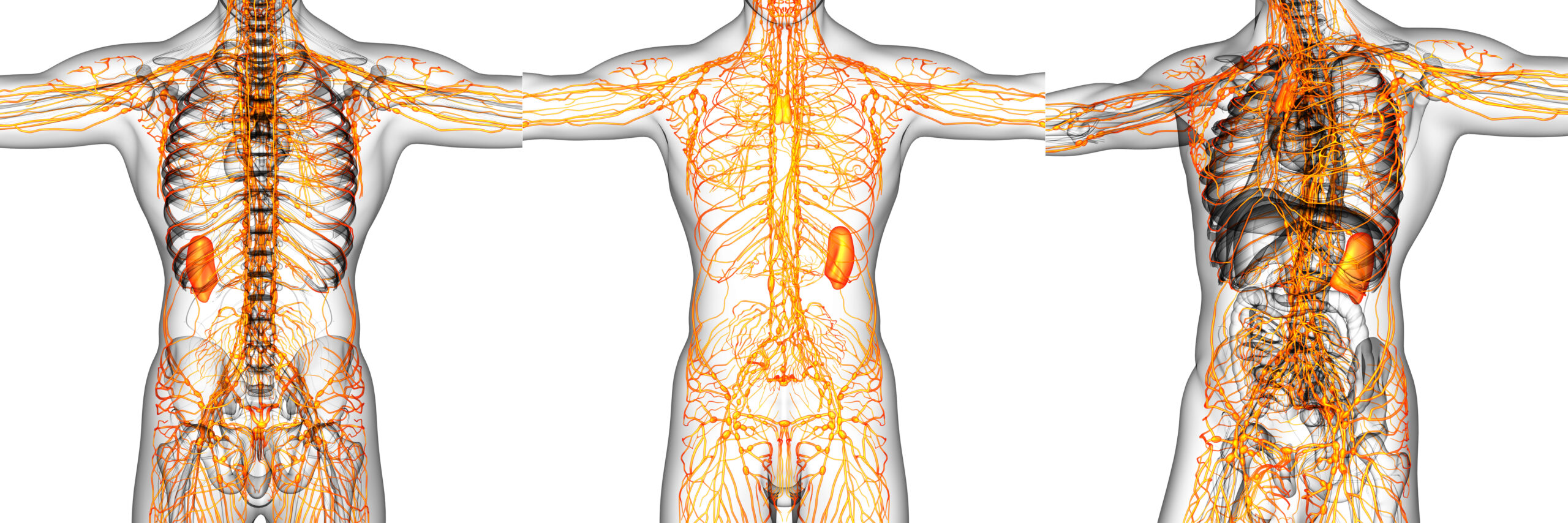Lymphedema Treatment
Personalized manual lymphatic drainage, compression therapy, and improve lymphatic flow.
What is Lymphedema?
Lymphedema is swelling in the arms or legs due to a disruption of lymph fluid flow through the lymphatic system. This disruption causes fluid to accumulate under the skin. The most common cause of lymphedema is the removal of lymph nodes. About one in five women who are living with or beyond breast cancer and who have had the lymph nodes in their underarm removed during breast cancer treatment will develop lymphedema. You can learn more about the causes and daily struggles of Lymphedema here.
Lymphedema may manifest as an inherited condition. However, it predominantly arises from obstructions in the lymphatic vessels caused by infections, cancer, and the formation of scar tissue resulting from radiation therapy or surgical removal of lymph nodes.
The likelihood of developing lymphedema is higher if you:
- Underwent surgery to remove lymph nodes in the underarm, groin, or pelvic regions.
- Received radiation therapy in the underarm, groin, pelvic area, or neck.
- Have scar tissue in the lymphatic ducts, veins, or beneath the collarbones due to surgery or radiation therapy.
- Received taxane chemotherapy.
- Have cancer that has spread to the lymph nodes in the neck, chest, underarm, pelvis, or abdomen.
- Have tumors in the pelvis, abdomen, or chest that exert pressure on the lymphatic vessels or ducts, hindering fluid drainage.
- Experience inflammation in the arm or leg following surgery.
- Are elderly.
- Have an inadequate diet or are overweight. These circumstances may impede recovery from surgery and radiation therapy, increasing the risk of developing lymphedema.

Is Lymphedema Physical Therapy Right For Me?
Physical Therapy can play a crucial role in helping with lymphedema, below are some ways physical therapy can treat symptoms:
- Assessment and diagnosis: A physical therapist will conduct a thorough assessment of the affected limb(s) to determine the severity and extent of the lymphedema.
- Education: A physical therapist will educate the patient about the causes and symptoms, as well as the importance of self-care and preventative measures.
- Manual lymphatic drainage: A physical therapist can perform gentle massage techniques designed to stimulate the lymphatic system, promote lymphatic fluid flow, and reduce swelling.
- Compression therapy: A physical therapist may recommend compression garments or bandages to help reduce swelling and prevent the accumulation of lymphatic fluid.
- Exercise: A physical therapist can design an exercise program that helps to promote lymphatic fluid flow and improve muscle strength and flexibility.
- Lifestyle modifications: A physical therapist can offer advice on lifestyle modifications, such as diet and hydration, that can help to manage symptoms.
Move better. Live better.
Move better.
Live better.
PhysioFit Physical Therapy & Wellness, like Los Altos itself, combines an inviting, community environment with exceptional talent. Founded and led by Kim Gladfelter, a keen, well-rounded expert of healing through movement and a dedicated team who takes a holistic approach to optimal health.
Signs & Symptoms of Lymphedema
Swelling of part or all of the arm or leg, including fingers or toes.
A feeling of heaviness or tightness.
Restricted range of motion.
Recurring infections.
Hardening and thickening of the skin (fibrosis)
How Lymphedema Treatment Works:
Emotions you may be experiencing
- Uncomfortable
- Limited with activities
- Self-conscious
Understand your symptoms
- Thorough talk with your therapist
- Go over weak areas
- See what causes pain
- Test GAIT & balance
- Determine lifestyle contributors


Typical limitations with activities
- Limited range of motion
- Fatigue and weakness
- Compression garment dependency
- Heat and humidity sensitivity
- Occupational limitations
- Exercise limitations
- Psychological impact
Get the care you need
- Get personalized treatment
- Direct relationship with specialist
- Review goals and set milestones
- Focus on a holistic approach to your treatment
Get your desired outcome
- Return to daily walks
- Able to increase mobility to do yard work, cook, write, eat
- Able to put rings back on
- Able to work comfortably again at the computer

Let's Get Started!
What You Won't Get At PhysioFit
- You won’t be treated by a physical therapist treating 2-4 other people in the same room.
- You won’t waste time playing musical chairs on useless machines.
- You won’t be with a therapist for 5-10 minutes, where they show you the same basic exercises they give to everyone – regardless of what YOU might actually be going through.
- Your treatment will NEVER be influenced by what an insurance company will cover.
- We’ll never tell you, “This just happens as we get older, just take some pain medication.”
What Our Clients Say
H.S.
“I was totally skeptical coming in. Even a little resistant. But I had the best session ever. I keep waiting for “the catch”. Like, how could this have possibly worked within an hour– something that I’ve been carrying around, in and out of therapy, for years? But now, two months later, I still feel free of my burden. Before I left, I took a bunch of Divya’s business cards. I have a few friends who could really use her help!”
Los Altos, CA
D.A.
“I have been seeing Janet Perrino for multifaceted neuro-muscular-skeletal-joint issues combined with fibromyalgia. Janet’s knowledge of anatomy and how it affects the function of body parts is golden and unmatched by any other physical therapist or even doctors. She was able to quickly figure out my problems and find solutions that resulted in, pretty much, instant improvement and pain relief. Incredibly grateful for all the help and treatments.”
Los Altos, CA
Want Some Help?
Choose Which One Works Best For You...
Just click one of the buttons above and then fill out the simple form.
Free Guide On Lymphedema Treatment:
"How to handle lymphedema symptoms."


 Los Altos, CA
Los Altos, CA




